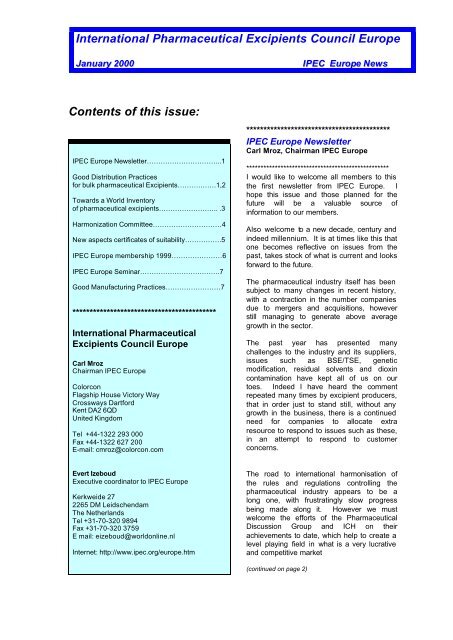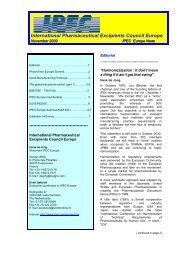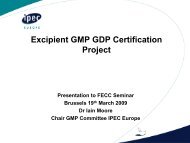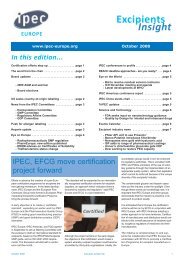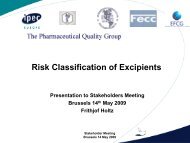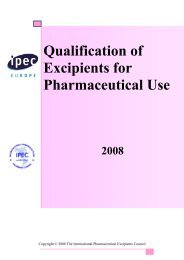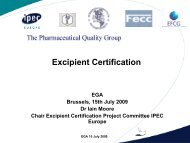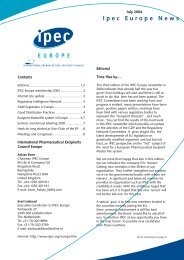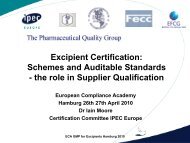International Pharmaceutical Excipients Council ... - IPEC Europe
International Pharmaceutical Excipients Council ... - IPEC Europe
International Pharmaceutical Excipients Council ... - IPEC Europe
Create successful ePaper yourself
Turn your PDF publications into a flip-book with our unique Google optimized e-Paper software.
<strong>International</strong> <strong>Pharmaceutical</strong> <strong>Excipients</strong> <strong>Council</strong> <strong>Europe</strong>January 2000<strong>IPEC</strong> <strong>Europe</strong> NewsContents of this issue:<strong>IPEC</strong> <strong>Europe</strong> Newsletter…………………………...1Good Distribution Practicesfor bulk pharmaceutical <strong>Excipients</strong>……….…….1,2Towards a World Inventoryof pharmaceutical excipients…………………….. .3Harmonization Committee…………………………4New aspects certificates of suitability…………….5<strong>IPEC</strong> <strong>Europe</strong> membership 1999………….………6<strong>IPEC</strong> <strong>Europe</strong> Seminar……………………….…….7Good Manufacturing Practices……………………7******************************************<strong>International</strong> <strong>Pharmaceutical</strong><strong>Excipients</strong> <strong>Council</strong> <strong>Europe</strong>Carl MrozChairman <strong>IPEC</strong> <strong>Europe</strong>ColorconFlagship House Victory WayCrossways DartfordKent DA2 6QDUnited KingdomTel +44-1322 293 000Fax +44-1322 627 200E-mail: cmroz@colorcon.com******************************************<strong>IPEC</strong> <strong>Europe</strong> NewsletterCarl Mroz, Chairman <strong>IPEC</strong> <strong>Europe</strong>**************************************************I would like to welcome all members to thisthe first newsletter from <strong>IPEC</strong> <strong>Europe</strong>. Ihope this issue and those planned for thefuture will be a valuable source ofinformation to our members.Also welcome to a new decade, century andindeed millennium. It is at times like this thatone becomes reflective on issues from thepast, takes stock of what is current and looksforward to the future.The pharmaceutical industry itself has beensubject to many changes in recent history,with a contraction in the number companiesdue to mergers and acquisitions, howeverstill managing to generate above averagegrowth in the sector.The past year has presented manychallenges to the industry and its suppliers,issues such as BSE/TSE, geneticmodification, residual solvents and dioxincontamination have kept all of us on ourtoes. Indeed I have heard the commentrepeated many times by excipient producers,that in order just to stand still, without anygrowth in the business, there is a continuedneed for companies to allocate extraresource to respond to issues such as these,in an attempt to respond to customerconcerns.Evert IzeboudExecutive coordinator to <strong>IPEC</strong> <strong>Europe</strong>Kerkweide 272265 DM LeidschendamThe NetherlandsTel +31-70-320 9894Fax +31-70-320 3759E mail: eizeboud@worldonline.nlInternet: http://www.ipec.org/europe.htmThe road to international harmonisation ofthe rules and regulations controlling thepharmaceutical industry appears to be along one, with frustratingly slow progressbeing made along it. However we mustwelcome the efforts of the <strong>Pharmaceutical</strong>Discussion Group and ICH on theirachievements to date, which help to create alevel playing field in what is a very lucrativeand competitive market(continued on page 2)
<strong>International</strong> <strong>Pharmaceutical</strong> <strong>Excipients</strong> <strong>Council</strong> <strong>Europe</strong>News________________________________________________________________(continued from page 1)With the advancement of the Internet andincreased use of e-commerce, internationalboundaries will disappear much faster thanpreviously anticipated, thus creating a globalmarket whether our regulators or marketingcolleagues like it or not.We still find today that the manufacture andsupply of excipients to the pharmaceuticalindustry is an unregulated activity.However there appears to be something realon the horizon with guidelines and legislationin preparation to control all starting materialsused in medicines. Most of us involved withthe production and use of excipients willwelcome the clarification such guidelinesshould provide and if thoughtfully preparedwill make life easier for both parties.In February 1999 the Directorate General IIIof the <strong>Europe</strong>an commission in Brusselsissued the last draft of a directive amending75/319/EEC requiring GMP for themanufacture of all starting materials used formedicinal products. In that directive, theactivities of distributors of excipients are alsodefined as “manufacture”, especially if theyrepack and relabel materials. That meansalso the supply chain of starting materialswill be covered by GMP in the EC. This is inlinewith the requirements for startingmaterials in the US regulation and necessaryregarding the regulatory basis of the mutualrecognition agreement between USA andthe EC leading to equivalence of both.After the terrible accident with contaminatedGlycerin in Haiti 1996 WHO held aconference on control and safe trade ofstarting materials in Geneva 1998.Many talk of the “excipient industry”, inreality there is no such thing. Principallywhat we have is a collection of bulk chemicalmanufacturers who sell some of their outputto pharmaceutical applications. Thisdiversity of companies manufacturingproducts to be used in medicines highlightsthe need for organisations like <strong>IPEC</strong> to exist,where they can share a common platformwith their customers and to have a two wayroute of communication with the industry’sregulators.Finally, the pharmaceutical industry alwayscreates a very dynamic environment inwhich to work and I am sure that you sharemy sense of both foreboding and excitementat the forthcoming challenges of the 21stcentury.***************************************************Good Distribution PracticesFrank Milek***************************************************GMP issues of the supply chain of excipientsare increasingly receiving the attention ofregulatory bodies, authorities and otherorganizations because many problems hadbeen recognized.There WHO realized deficiencies in safetyof starting materials and published astatement about necessary future GMPrequirements for starting materials and therelated supply chain, because an unsafe anduncontrolled supply chain could made thataccident possible. The first outcome is theAnnex 5 of WHO-GMP (Suppl. Guidelinesfor the manufacture of pharm. <strong>Excipients</strong>)published in May 1999 which does not coverspecial supply chain topics yet.(continued on page 3)______________________________________________________________________________________January 2000 2 <strong>IPEC</strong> <strong>Europe</strong> Newsletter________________________________________________________________
<strong>International</strong> <strong>Pharmaceutical</strong> <strong>Excipients</strong> <strong>Council</strong> <strong>Europe</strong>News________________________________________________________________(continued from page 2)Beside this CEFIC published two guidelinesto improve the supply chain of excipients:Guidelines for handling and distribution ofPropylene Glycol USP/EP and <strong>Europe</strong>anSingle Assessment for Chemical Distributors(ESAD, Appendix B). Both contain the sameprinciples improving quality, traceability anddocumentation while reducing the risk ofcross contamination within the supply chainof excipients.At the GMP-Workshop during the 1999Annual Meeting <strong>IPEC</strong> <strong>Europe</strong> started todiscuss this issue. Dr. Mathias Brenken(DOW Deutschland) and Dr. Frank Milek(Hedinger) held short lectures aboutchallenges and GMP`s for the supply chain.At a follow-up workshop in June 1999 asubcommittee of the GMP-Committee hasbeen formed. Members of this subcommitteeare Dr. Frank Milek (Hedinger,CHAIR), Dr. Mathias Brenken (DOWDeutschland Inc.). Alan Ritchie (ISP <strong>Europe</strong>)and Steve Campbell (SmithKline Beecham).On the basis of a draft Guideline forDistributors of Bulk <strong>Pharmaceutical</strong><strong>Excipients</strong> of <strong>IPEC</strong> America thesubcommittee now works on a harmonizedguideline on Good Distribution Practice(GDP) for the whole of <strong>IPEC</strong>. The structureis like a questionnaire which should be usedas a supplementary guideline to <strong>IPEC</strong>`sGMP for Bulk <strong>Pharmaceutical</strong> <strong>Excipients</strong>(1995) for auditing distributors.The subcommittee intends to create someadditional guidance for the use of thatquestionnaire and a position paper about<strong>IPEC</strong> <strong>Europe</strong>`s opinion and activitiesconcerning GDP. All that will be channeledto WHO supporting their work for moresafety within the whole supply chain.If there are any volunteers interested insupporting this subcommittee, pleasecontact:Dr. Frank MilekAug. Hedinger GmbH,Heiligenwiesen 26,D-70327 Stuttgart, GermanyE-mail: hedinger@t-online.de;Fax: +49 711 4020535;Tel: +49 711 402050******************************************A first attempt to create a WorldInventory of <strong>Excipients</strong> used inpharmaceutical formulationsFernand PellerinHenk de Jong (Servier)Anne Bonnetto (Servier)***************************************************************When consulting the Pharmacopoeia's anddictionaries containing monographs ofpharmaceutical excipients (e.g. VIDAL inFrance, Rote Liste in Germany, etc.), onearrives at an impressive list of "inactiveingredients".Within the <strong>International</strong> <strong>Pharmaceutical</strong><strong>Excipients</strong> <strong>Council</strong> <strong>Europe</strong>, it was thoughtuseful to try to establish a world inventory ofexcipients already in use in marketed, i.e.approved, pharmaceutical products. The firstuse would be for formulators in thepharmaceutical industry to have a quick andeasy reference as to the regulatory status ofan ingredient. The second use would be forregulators to cross-check statuses withterritories outside their own one.Ideally a future inventory would consist of aworld picture on all excipients in the form ofa collection of monographs describingidentity, properties, quality, type of use,safety data, route of administration, admittedmaximum dose, etc. In this first attempt, weonly created a listing of excipients byconsulting public sources of informationavailable to us:(continued on page 4)______________________________________________________________________________________January 2000 3 <strong>IPEC</strong> <strong>Europe</strong> Newsletter________________________________________________________________
<strong>International</strong> <strong>Pharmaceutical</strong> <strong>Excipients</strong> <strong>Council</strong> <strong>Europe</strong>News________________________________________________________________(continued from page 3)-The <strong>Europe</strong>an Pharmaopoeia-The United States Pharmacopoeia andNational Formulary-The Japanese Pharmacopoeia togetherwith Japanese <strong>Pharmaceutical</strong> <strong>Excipients</strong> (apro-pharmacopoeia)-The Japanese <strong>Pharmaceutical</strong> <strong>Excipients</strong>Directory (1994)-Inactive Ingredient Guide (FDA 1996)-VIDAL (marketed medicinal products inFrance)-Repertorio Farmaceutico Italiano (marketedpharmaceutical products in Italy)From this first listing, a number of substancehave been voluntarily excluded: activeingredients, flavours and fragrances, thevitamins (with an exception of theantioxidants, vitamins C and E) and thecolorants. The listing is presented in twoformats: alphabethical and by "chemicalclass". Both entries have their difficulties.The absence of an INN system for excipientsleads to a cacaphony of names: chemicalnames, traditional names, fantasy names,brand names, etc. many excipients havemore than one chemical functionality.We are strongly aware of the fact that thislist is not complete and it surely containssome errors. Readers are asked to forwardtheir comments, proposals for correctionsand additions to:***************************************************Professor Fernand Pellerin51 Rue Desnouettes75015 Paris (France)Fax: +33-1-4530 5069***************************************************During the Annual Meeting (January 21st2000), a proposal will be made to the <strong>IPEC</strong><strong>Europe</strong> membership to create a Committeeon this subject.**************************************************Dankward Jaekel, Chairman**************************************************Within the systematic working program ofthe Committee activities focus is at presenton the following topics:1. <strong>Europe</strong>an Pharmacopoeia:General monograph on <strong>Excipients</strong>The series of general monographs is atpresent further extended, including in futurealso a general monograph on excipients. Afirst draft had been discussed in theHarmonization Committee's workshop duringthe May 1998 <strong>IPEC</strong> <strong>Europe</strong> Symposium inNice, France. Many of our comments to the<strong>Europe</strong>an Pharmacopoeia, based on theresults of that workshop, have been takeninto consideration for the second draft of thegeneral monograph, published inPharmeuropa Volume 11, No 3.The draft requires that all excipients alsocomply with the requirements of the generalmonographs on:- products derived from recombinant DNAtechnology- Products derived from warm bloodedanimals- Products of fermentation- Residual solventsUnless otherwise justified and authorized therequirements apply as well to excipients thatare not the subject of a pharmacopoeialmonograph. Implications of the generalmonograph on excipients are currently underevaluation by the HarmoniszationCommittee. The Committee requests <strong>IPEC</strong><strong>Europe</strong> members for input:(continued on page 5)(continued from page 4)______________________________________________________________________________________January 2000 4 <strong>IPEC</strong> <strong>Europe</strong> Newsletter________________________________________________________________
<strong>International</strong> <strong>Pharmaceutical</strong> <strong>Excipients</strong> <strong>Council</strong> <strong>Europe</strong>News________________________________________________________________2. Cooperation with CEFIC on 1,2-PropyleneglycolWhile 1,2 propylene glycol is widely used fortechnical applications, only a very lowpercentage of the world production is usedas a pharmaceutical excipient. Due tocontamination/mix up with toxic diethyleneglycol, this product caused the death ofmany people. In order to ensure the safeuse of 1,2 propylene glycol inpharmaceuticals from production via thevarious distribution channels to the end usera CEFIC Working Group has developed atpresent a suitable protocol for distribution ofthis product (See also Dr Frank Milek'scontribution on Good Distribution Practices).In this context the CEFIC working Groupcontacted the Harmonisation Committee tojointly elaborate a proposal for a harmonizedcompendial monograph on 1,2 propyleneglycol. Work made good progress and a finaldraft is expected to become available in thefirst semester of 2000.3. Polyols and PEGClose cooperation with our collegues from<strong>IPEC</strong> Americas and JPEC on common <strong>IPEC</strong>proposals for harmonized monographs onpolyols (sorbitol,mannitol, maltitol and xylitol)and polyethylene glycols, PEG)4. Glyoxal determinationThe colorimetric method used at present forthe quantitative determination and limitationof glyoxal detects only free but not boundglyoxal, which is split off again under invivoconditions. Development of a method todetrmine both, free and bound, glyoxalwithout interference from other substancesturned out to be difficult. The Committee islooking for practical experience from otherlaboratories to solve this problem.******************************************Dankward JaekelChair Harmonisation CommitteeC/0 Novartis PharmaE-mail:dankward.jaekel@pharma.novartis.comFax: +41-62-868 7069******************************************New Aspects of the procedure forthe Certification of Suitability ofMonographs of the <strong>Europe</strong>anPharmacopoeia.E. Izeboud (with permission of CarolineLarsen-Le Tarnec of the EDQM)More than 240 experts in the area of thequality of medicines from 24 <strong>Europe</strong>ancountries and also from Argentina, Israel,Egypt, Japan, India and the United States,participated in the <strong>International</strong> Conferenceon the procedure for the Certification ofSuitability of Monographs of the <strong>Europe</strong>anPharmacopoeia, organized by the <strong>Europe</strong>anDirectorate for the Quality of Medicines.<strong>IPEC</strong> <strong>Europe</strong> was well presented by 29representatives of the membership. Dr BrianCarlin of FMC Biopolymer, Chair of <strong>IPEC</strong><strong>Europe</strong>'s Excipient Masterfile Committee,presented a lecture on <strong>IPEC</strong> <strong>Europe</strong>'sproposals to extend the procedure of<strong>Europe</strong>an Drug Masterfiles topharmaceutical excipients. After thepresentation it became evident that theEMEA does not consider this topic ashaving a high priority.The objectives of this conference wereparticularly important since they involvedreviewing the results of five yearsexperience sharing the points of view with(continued on page 6)(continued from page 5)______________________________________________________________________________________January 2000 5 <strong>IPEC</strong> <strong>Europe</strong> Newsletter________________________________________________________________
<strong>International</strong> <strong>Pharmaceutical</strong> <strong>Excipients</strong> <strong>Council</strong> <strong>Europe</strong>News________________________________________________________________principal users and examining the currentsituation as regards the quality of rawmaterials used in the pharmaceuticalindustry.After two days of exchanging views , threemain ideas for future development hadbecome apparent:1. Extending the scope of the Certificationprocedure to products with risk of TSE(transmissible spongiform encephalopathy)2. Strenghtening cooperation between thevarious partners.3. Improving the transparency of thecertificates and making it possible theassess stability studies to facilitate theevaluation of licensing dossier by nationalauthorities and avoid duplication of work.******************************************<strong>IPEC</strong> <strong>Europe</strong> Membership 1999E.Izeboud**************************************************The last year of the 2nd millennium was adynamic year for the <strong>IPEC</strong> <strong>Europe</strong>membership: a merger, a take-over and acompany in financial difficulties were thecause of the loss of three full members.<strong>IPEC</strong> <strong>Europe</strong>'s membership recruitmentprogram however was strong enough tocope with these circumstances, whicheventually resulted in the fact that theobjective of 1999 (60 full members) wasexceeded by one. <strong>IPEC</strong> <strong>Europe</strong> has thusbecome the unified voice of excipient usersand producers. In 1999 the <strong>IPEC</strong> <strong>Europe</strong>Board approved the applications of thefollowing members:Eli Lilly (user)Lyondell (maker)Wolff Walsrode (maker)Quadrant Healthcare (user)Banner Pharmacaps <strong>Europe</strong> (maker)Akzo-Nobel (user/maker)Metsa Specialty Chemicals (maker)Pfizer (user)Firmenich (maker)Mustafa Nevzat (user)Dr Paul Lohmann (maker)Of special interest is the representation ofthe Turkish company Mustafa Nevzat in<strong>IPEC</strong> <strong>Europe</strong>. In view of the outcome of the<strong>Europe</strong>an Union's considerations for newmember states, Turkey was defined as aserious candidate. For a long time in historyTurkey has been the stronghold for tradetransactions with the neighboring Asiancountries.***************************************************NoteDuring the IPTS seminar in September 1998in Ankara I discovered that in the Turkishlanguage the word IPEK stands for silk….Evert Izeboud******************************************<strong>Europe</strong>an Pharmacopoeia 2000******************************************Since November 1999 the CD-ROM 2000version of the <strong>Europe</strong>an Pharmacopoeia isavailable at the <strong>Europe</strong>an Directorate for theQuality of Medicines. It has beensupplemented with 200 new or revisedstandards, entering into force on January 1st2000.The CD-ROM 2000 includes all texts (inEnglish and/or French) of the 3rd Edition ofthe <strong>Europe</strong>an Pharmacopoeia andsupersedes all the previous versions(1997,1998 and 1999). The CD-ROM 2000contains about 1450 monographs, 276general methods of analysis, the full list of1300 reagents as well as the latestcatalogue of 1150 chemical referencesubstances or biological referencepreparations.The CD-ROM is very user friendly, makinguse of useful hyperlinks form the text of themonograph to the corresponding analyticalmethods and chemical reagents. For heavyusers of the <strong>Europe</strong>an Pharmacopeia animprovement in efficiency.______________________________________________________________________________________January 2000 6 <strong>IPEC</strong> <strong>Europe</strong> Newsletter________________________________________________________________
<strong>International</strong> <strong>Pharmaceutical</strong> <strong>Excipients</strong> <strong>Council</strong> <strong>Europe</strong>News________________________________________________________________Program <strong>IPEC</strong> <strong>Europe</strong> SeminarSheraton Brussels AirportJanuary 20th 2000.1. IntroductionMr Carl Mroz (Colorcon, Chair of <strong>IPEC</strong><strong>Europe</strong>)10.30-10.452. Genetically Modified OrganismsMaize from GMO sourcesDr Holger Mahlmann (Cerestar)10.45-11.153. BSE/TSEMr Kevin Mahoney (Glaxo Wellcome)11.15-11.454. Products from FermentationMr Cees van der Vlies ( Sertipharm,<strong>Europe</strong>an Pharmacopeia Commission)11.45-12.15Mr Allert Wiersema (DSM Anti-Infectives)Validation of fermentation processes12.15-12.45-----------------------------LUNCH 13.00-14.00-----------------------------5. ICH Guidelines on Residual SolventsProf Henk de Jong (Servier)14.00-14.306. Good Manufacturing PracticesMrs Anne Papin (EFPIA)14.30-15.007. WHO GMP… controlling the supplychain of pharmaceutical excipients.Mrs Patricia Rafidison (Dow Corning)15.00-15.308. Panel Discussion15.30-16.00******************************************Good Manufacturing PracticesE. Izeboud**************************************************In the area of Good Manufacturing Practices,currently three working committees areactive within <strong>IPEC</strong> <strong>Europe</strong>:1. Good Distribution Practices (see article byFrank Milek)2.Guidance tools <strong>IPEC</strong> Good ManufacturingPractices, andThe GMP Guidance tools Committee hasdefined as its mission to elaborate guidancedocuments and templates for GMP subjectswhich need to be clarified. With reference tothe outcome of the GMP Forum on January21st 1999 in Brussels and the follow-up onJune 16th 1999 in Amsterdam two prioritysubjects have been set: impurities inpharmaceutical excipients (groupleader, MrsDoris Wangel of Flamel Technologies andvalidation protocols (groupleaders, MalcolmDixon of Eli Lilly and David Spence ofICI/Uniqema).3. Regulatory Survey CommitteeThe Regulatory Survey Committee ( MrsPatricia Maillere of Servier and Mr Jean-Claude Lumaret of Roquette) is working onconstructing a database of legislativedocuments (worldwide) relating to GoodManufacturing Practices. For the purpose tocommunicate this information to the <strong>IPEC</strong><strong>Europe</strong> membership a dedicated page on<strong>IPEC</strong> <strong>Europe</strong>'s Internetsite is underconstruction. During the Annual Meeting onJanuary 21st 2000 in Brussels the GoodManufacturing Practices page will beopened.______________________________________________________________________________________January 2000 7 <strong>IPEC</strong> <strong>Europe</strong> Newsletter________________________________________________________________
<strong>International</strong> <strong>Pharmaceutical</strong> <strong>Excipients</strong> <strong>Council</strong> <strong>Europe</strong>News______________________________________________________________________________________________________________________________________________________January 2000 8 <strong>IPEC</strong> <strong>Europe</strong> Newsletter________________________________________________________________


